Foreign Insulators
by Marilyn Albers
Reprinted from "Crown Jewels of the Wire", February 2000, page 4
NEW PORCELAIN INSULATOR STYLES FOUND IN FRANCE
Jim and Lis Bergman of Anchorage, Alaska were able to find several new
porcelain styles while on recent trips to France and have offered to share the
following information with Crown Jewels of the Wire readers.
The first three photos show all sides of an unmarked brown glazed insulator
which Jim calls a 'French Cowboy Hat'. It is 3" tall and has a base
diameter of 4".
My description of this unusual piece gets a bit fuzzy, but
Jim says that it is definitely an insulator, though he doesn't know its purpose.
He found it in a trash bin and rescued it! Originally there was a smooth short
metal pin cemented into the threadless pin hole on the underside, but it has
been removed. The conductor groove in the crown probably held tie wires which
secured the insulator onto a metal band, much like a watch would be attached to
a wristband. The two tilts in the skirt of the insulator allowed rain water to
run off. Does anyone know how this insulator may have been used?
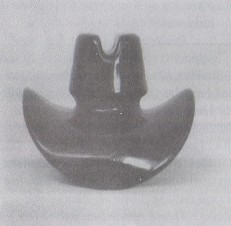
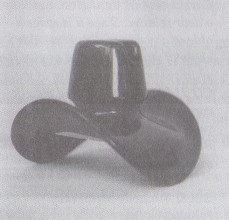
Front view and side view of
French Cowboy Hat
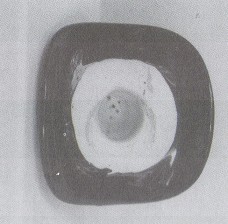
Underside of the
French Cowboy Hat insulator
This insulator was made by a French porcelain insulator company known as
Anciens Etablissements Parvillee Freres & Cie. or "Long Established
Plants of Parvillee Brothers & Co.", which is located in Cramoisy in
the French Department of Oise. Compared to American styles, the profile of this
one is truly unique. It is very attractive with its white glaze and the marking
P.F.C. (over) DEPOSE ink stamped in dark green ink on the upper part of the
insulator. (The French word DEPOSE indicates that P.F.C. is the registered
trademark of the company). This insulator is 6-5/8" in height and has a base
diameter of 5-3/4'" It tips the scale at 4-1/2 pounds, so it's pretty
obvious that it was designed for use on a high voltage power line. The thick
triple skirts and 1-1/4" threaded pin hole further guarantee its
sturdiness.
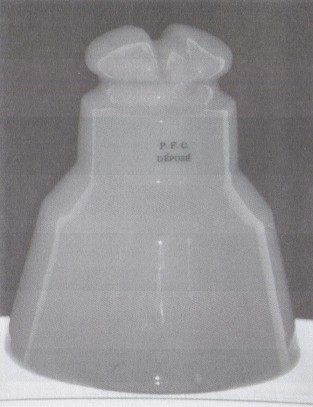
An interesting high voltage P.F.C. insulator
The glaze color of this insulator is a medium green with the 'P.F.C.'
trademark on one side of the crown and 'AT 75' in the same location on the
opposite side. It is 4-1/8" tall and measures 2-1/2" across the
extended inner skirt on which it stands. This particular example still has the
metal pin cemented into it so I can't really tell if the pin hole is threaded or
not, but I suspect it is. Even though it's a fairly common style it's really a
pretty insulator! I hadn't seen one quite like it until now.
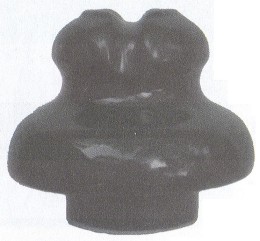
A low voltage P.F.C. insulator
A gingerbread 'baby' has been added to the lineup of gingerbread styles! See
the little white glazed insulator to the left in the photo below it's a new find
just 3-1/4" tall. The gingerbread boy on the right is the most common size
at approximately 3-3/4" in height and though they are not plentiful, they
are still available at some insulator shows. As far as I know, none of the
gingerbread styles is marked, but it's still interesting to see how many
different sizes have already been discovered.
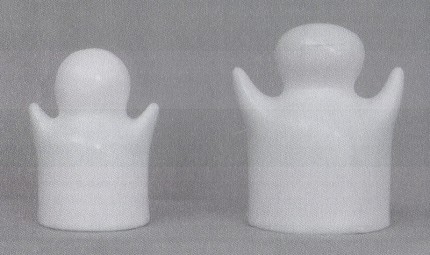
Gingerbread Baby and a Gingerbread Boy
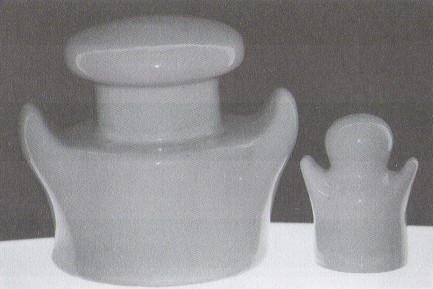
Largest Gingerbread style dwarfs Gingerbread Baby
You may remember that the February 1999 issue of Crown Jewels of the Wire
magazine included a line up of all the gingerbread styles that were known at
that time, including a very large one found in Belgium by Dale Huber of Colfax,
California. We called it the Gingerbread 'Grandma'. That one was 4-1/2" tall
with a base diameter of3-5/8" and an arm span of 5". It tipped the
scale at 2-1/2 lbs. and we marveled!
Enter 'Great Grandma' - take a look at the
photo just above. Jim was able to find an example of this style that's even
larger than the one Dale has. It is 5-1/4" in height with a base diameter
of 4-1/2" and a 6" arm span. This insulator weighs 4-1/4" lbs. and
for now it's the grand champion of the gingerbread family! It really does dwarf
the little gingerbread 'baby' sitting beside it.
I really don't know much
about these T-bars (pictured on the following page) because there is no marking
on either of them but at least they are new profiles from France, which is
always interesting to see. The smallest one on the left is just 2" in
height with a base diameter of 1-5/8" and an arm span of 3". I really
like these little ones.
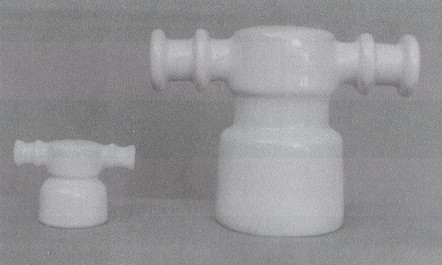
French T-bars, tiny to tall
The large T-bar on the right is a beauty and appears to
be a very sturdy insulator. It is 5-7/8" tall with a base diameter of 3-1/4" and an 6-5/8" arm span. Both of these insulators (bottom picture
on the next page) are new porcelain styles from France but neither one has any
marking. The little Noser on the left is 2-3/8" tall and has a base diameter of 2". The
skirt of the insulator is only 3/16" thick so it is fairly susceptible to
breakage. These small insulators were fixed on the outside of buildings and
designed to carry low voltage to the inside.
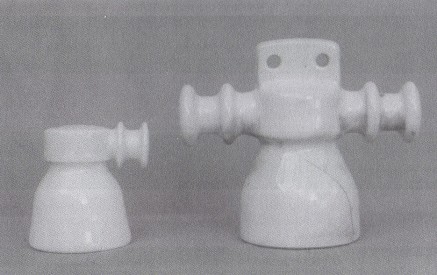
A Baby Noser and a new style of Robot
The odd looking insulator to the
right in the photo (below) has been nicknamed the "Robot". It was used
as a fuse insulator and can be
identified as such by the two holes in the crown. Several different sizes
have been made in glass but the porcelain version is not so easy to find so Jim
is proud to have found this one.
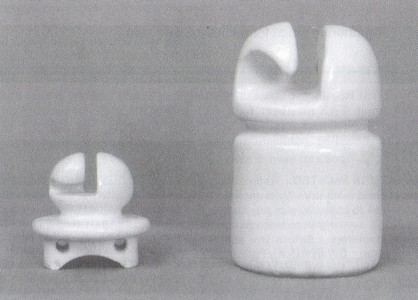
The Cody Lyon Patent
These last two insulators are unmarked as are all the others in this article.
The larger one is 4-1/8" in height and has a base diameter of 2-1/2".
When I asked N.R. Woodward about the strange configuration on the crowns of both
pieces in the photo he said they were called "twist lock self tying
insulators" and that some time ago a fellow named Cody Lyon from Emmett,
Idaho designed a similar insulator. The patent number for his design was
217,032. However, Jim's insulator was found in France but since it has no
marking we have no way of knowing what company made it.
Other examples of the twist lock self tying insulator have been found in
Cuba, Spain, Portugal and England. The smaller piece shown in the photo is not a
pin type insulator and I have no idea how it was used. If any of our Crown
Jewels subscribers have an answer to this one, please let me know.
Many thanks
to Jim and Lis for sharing.
| 